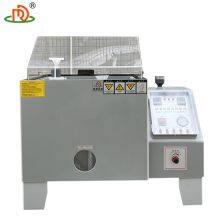Salt Spray Testing Equipment for Power Tools - UL 746A Material Evaluation
Model | DR-H304-90(120、200) |
Internal Size (W*D*H) | 900x600x500mm |
External Size (W*D*H) | 1410x880x1280mm |
Chamber material | P.V.C rigid plastic plate, thickness 8mm |
Sample tray | Diameter 10mm glass fiber rod, anti-rust V-shape plastic steel to make sure sample in 15~30 degree inclined |
Temperature Range | Room temperature ~ 55℃ |
Temperature Fluctuations | ≤±0.5℃ |
Temperature Uniformity | ≤±2℃ |
Temperature Precision | ±1℃ |
Spraying method | Continuous and Periodic spray type |
Test Chamber Temperature | Salt Spray Method (NSS ACSS)35±1℃ |
Saturated air Barrel Temperature | Salt Spray Method (NSS ACSS)47±1℃ |
Brine Temperature | 35℃±1℃ |
Spray Quantity | 1.0~2.0 ml / 80cm2 / hr |
PH value | Salt Spray Method (NSS ACSS6.5~7.2) |
Lab Volume | 108L |
Brine Tank Capacity | 25L |
Multiple Safety Protection Devices | Current discharge protection, over pressure protection, over temperature protection, over load fuse protection |
Accessories | Testing Salt/ Measuring tank/Nozzle Equipment x 1 set |
Air source | 1HP Air pump (provided by buyer) |
The operating environment of the salt spray test chamber needs to meet certain conditions to ensure the normal operation of the equipment and the accuracy of the test results. The following are the specific requirements for the operating environment of the salt spray tester:
Environmental conditions
Temperature: the operating temperature of the salt spray test chamber should generally be between 5 ℃ ~ 35 ℃ to ensure the normal operation of the equipment and the accuracy of the test results. Too high or too low a temperature may affect the performance of the equipment and the stability of the test.
Humidity: The ambient humidity should be no more than 85% to prevent high humidity from causing moisture or malfunctioning of the internal components of the equipment.
Ventilation: The salt spray tester should be placed in a well-ventilated area to avoid corrosive gases generated during the test from accumulating in the room, which may affect the health of the operator and the service life of the equipment.
Horizontal placement: the equipment should be placed on a smooth horizontal ground to ensure the uniformity of the temperature and salt spray distribution inside the chamber during the test, and to avoid testing errors caused by tilting of the equipment.
Avoid direct sunlight: the salt spray tester should be avoided to be placed in the place of direct sunlight, so as to avoid the sunlight irradiation leading to an abnormal increase in the temperature of the box, which will affect the normal operation of the equipment and the accuracy of the test results.
Safety requirements
Grounding protection: the salt spray test chamber must be reliably grounded to prevent safety accidents caused by equipment leakage. The grounding wire should comply with relevant electrical safety standards to ensure the safety of the equipment during operation.
Keep away from flammable and explosive materials: the equipment should be placed in a place far away from flammable and explosive materials to avoid dangerous situations such as fire or explosion caused by sparks or high temperature that may be generated during the test.
Operation Convenience
Operation space: there should be enough operation space around the salt spray test chamber to facilitate the operator to carry out the maintenance, repair and test operation of the equipment. For example, it should be ensured that there is enough space on the front of the equipment to open the door, and space on the sides and back for piping connection and inspection.
Power supply stability: The equipment should be connected to a stable power supply to avoid voltage fluctuations affecting the operation of the equipment. It is recommended that equipment such as a voltage regulator be used to ensure the stability of the power supply to ensure that the salt spray test chamber can continue to operate in a stable manner.
Other requirements
Drainage system: the salt spray test chamber should be placed in a place with good drainage conditions, so that the waste water generated during the test can be discharged in a timely manner to avoid the accumulation of water on the equipment and the surrounding environment.
Pre-treatment space: in the vicinity of the salt spray test chamber should have the specimen pretreatment space and conditions, such as cleaning, drying, etc., so that before and after the test on the specimen for the necessary processing to ensure the accuracy of the test results.
The operating environment of the salt spray test chamber needs to take into account the environmental conditions, safety requirements, ease of operation and other relevant factors to ensure that the equipment can operate stably and safely, and obtain accurate and reliable test results.

Send Inquiry to This Supplier
You May Also Like
-
Humidity Environmental Tester Hamber - Material EnduranceUS$ 3999 - 9999MOQ: 1 Set
-
High-Humidity Environmental Chamber - 98%RH Dew Point ControlUS$ 3999 - 9999MOQ: 1 Set
-
Low-Temperature Humidity Chamber - -40℃ to +150℃ Temperature RangeUS$ 3999 - 9999MOQ: 1 Set
-
Three-Zone Humidity Chamber - Independent Temperature/Humidity ControlUS$ 3999 - 9999MOQ: 1 Set
-
Fast-Response Humidity Tester - 5%RH/min Humidity Change RateUS$ 3999 - 9999MOQ: 1 Set
-
Automotive Electronics Humidity Chamber - GM 9537P Humidity TestingUS$ 3999 - 9999MOQ: 1 Set
-
Automotive Electronics Humidity Chamber - GM 9537P Humidity TestingUS$ 3999 - 9999MOQ: 1 Set
-
Ipx4 Ipx5 Ipx6 Rain Water Spray Resistance Test ChamberUS$ 3000 - 5000MOQ: 1 Set
-
Ipx34 Water Rain Spray Test ChamberUS$ 3000 - 5000MOQ: 1 Set
-
IEC 60068 Stainless Steel Rain Test ChamberUS$ 3000 - 5000MOQ: 1 Set










